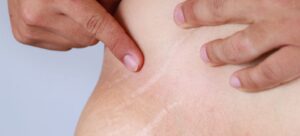Pregnancy is a beautiful journey, but it brings significant changes to your body—including the appearance of stretch marks. These marks, while common and completely natural, can be a source of concern for many expecting mothers. In this article, we’ll explore why stretch marks develop during pregnancy, how to prevent them, and effective care strategies to manage their appearance.
Why Do Stretch Marks Occur During Pregnancy?
Stretch marks, or striae gravidarum, are a result of rapid skin stretching and hormonal changes. As your baby grows, your skin stretches to accommodate the increased size of your abdomen, breasts, and other areas. This rapid stretching can cause the middle layer of the skin (dermis) to tear, leading to visible lines or streaks.
Hormonal Factors
During pregnancy, increased levels of hormones like cortisol weaken the skin’s elastic fibers. This makes the skin more prone to tearing under pressure, which contributes to the development of stretch marks.
Genetic Predisposition
Genetics play a significant role in whether you’ll develop stretch marks. If your mother or close relatives had them during pregnancy, you’re more likely to experience them too.
When Do Stretch Marks Typically Appear?
Stretch marks usually appear during the second and third trimesters of pregnancy, as the rate of weight gain and skin stretching increases. Common areas include:
- Abdomen
- Breasts
- Hips
- Thighs
- Lower back
Can Stretch Marks Be Prevented?
While it’s not always possible to completely prevent stretch marks, there are several steps you can take to minimize their likelihood or reduce their severity:
1. Keep Your Skin Hydrated
- Apply moisturizers rich in cocoa butter, shea butter, or hyaluronic acid to keep your skin supple.
- Use oils like almond oil or coconut oil to lock in moisture and improve elasticity.
2. Maintain a Healthy Diet
- Incorporate foods rich in vitamins C and E, which promote collagen production and skin repair.
- Eat foods high in zinc, such as nuts and seeds, to support skin health.
- Stay hydrated by drinking plenty of water throughout the day.
3. Control Weight Gain
- Aim for gradual and healthy weight gain as recommended by your healthcare provider. Rapid weight changes can increase the risk of stretch marks.
4. Use Preventative Products
- Look for products specifically designed for pregnancy, such as stretch mark prevention creams or serums containing ingredients like centella asiatica or retinol alternatives (safe for pregnancy).
Caring for Stretch Marks After Pregnancy
If you notice stretch marks developing during pregnancy, there are ways to manage and reduce their appearance after delivery:
1. Topical Treatments
- Retinoids: Products containing retinoids (e.g., tretinoin) can help rebuild collagen and reduce the appearance of stretch marks. Note: These are not safe during pregnancy but can be used post-delivery with doctor approval.
- Hyaluronic Acid: Helps to hydrate and plump the skin, making stretch marks less noticeable.
- Vitamin E Creams: Promote skin repair and improve texture.
2. Professional Treatments
For more significant results, consider professional interventions:
- Microneedling: Stimulates collagen production by creating tiny micro-injuries in the skin.
- Laser Therapy: Targets discoloration and improves skin texture.
- Chemical Peels: Exfoliates the surface layer of the skin, encouraging regeneration.
3. Massage and Exfoliation
- Regularly massage the affected areas to improve circulation and break down scar tissue.
- Use gentle exfoliators to remove dead skin cells and promote skin renewal.
Emotional Impact of Stretch Marks
Stretch marks are a natural part of pregnancy and a reminder of the incredible journey your body has undergone to bring life into the world. However, societal pressures can sometimes make them a source of insecurity. Here are some tips to embrace and celebrate your postpartum body:
- Focus on the amazing things your body has accomplished.
- Join communities of mothers who share their stretch mark stories and tips.
- Use affirmations to remind yourself of your strength and beauty.
FAQs About Stretch Marks During Pregnancy
1. Are Stretch Marks Permanent?
Stretch marks may fade over time but rarely disappear completely. With proper care, their appearance can be minimized.
2. Can I Start Preventative Care After Stretch Marks Appear?
Yes, even if stretch marks have already formed, applying moisturizers and using treatments can improve their appearance.
3. Are Stretch Mark Treatments Safe While Breastfeeding?
Most topical treatments like hyaluronic acid and vitamin E are safe during breastfeeding, but always consult your doctor before starting new products or treatments.
Conclusion
Stretch marks are a natural part of pregnancy, experienced by the majority of women. While they can’t always be prevented, proper care and a focus on skin health can help minimize their appearance. Remember, these marks are a testament to the incredible strength and resilience of your body.
Embrace your journey and take pride in what your body has achieved. Whether you choose to care for or simply accept your stretch marks, know that they are a beautiful part of motherhood.




